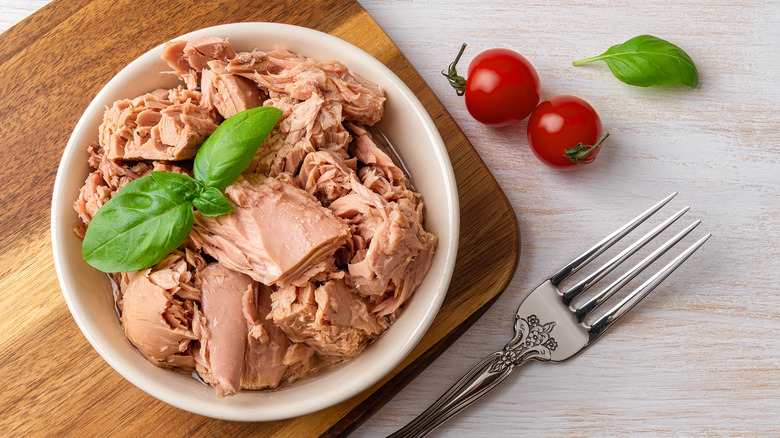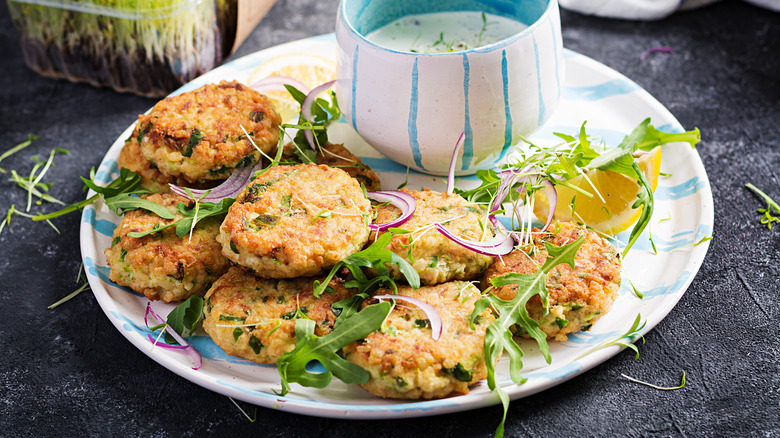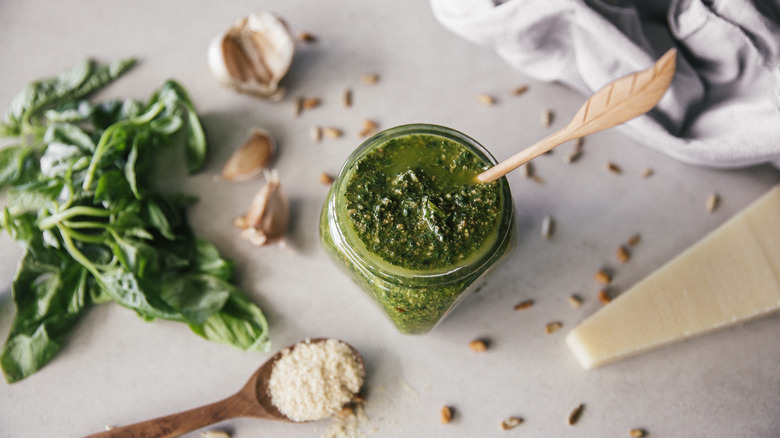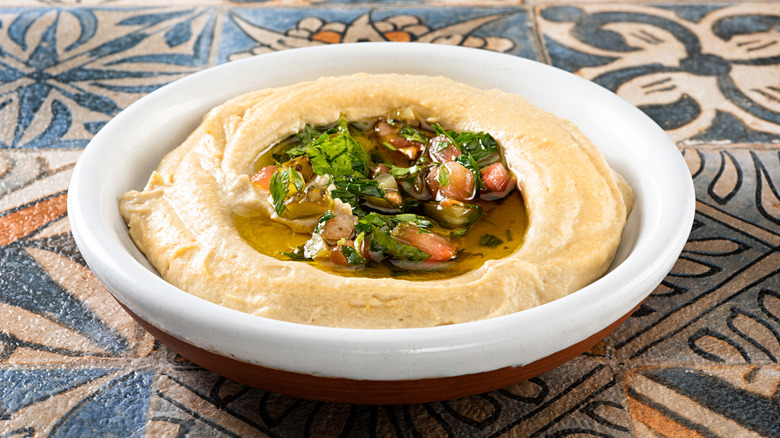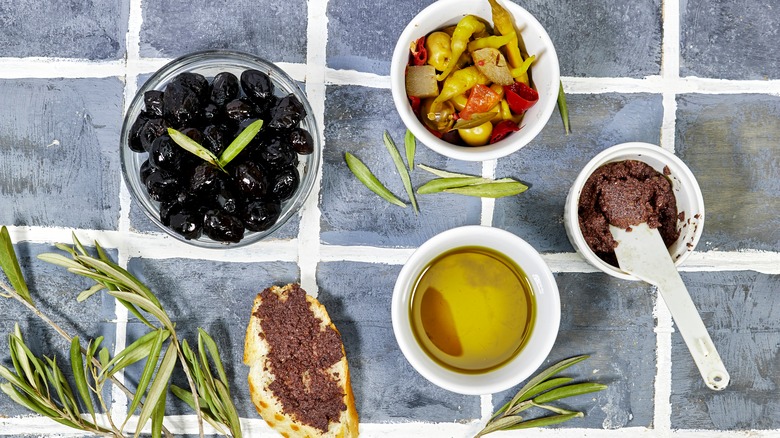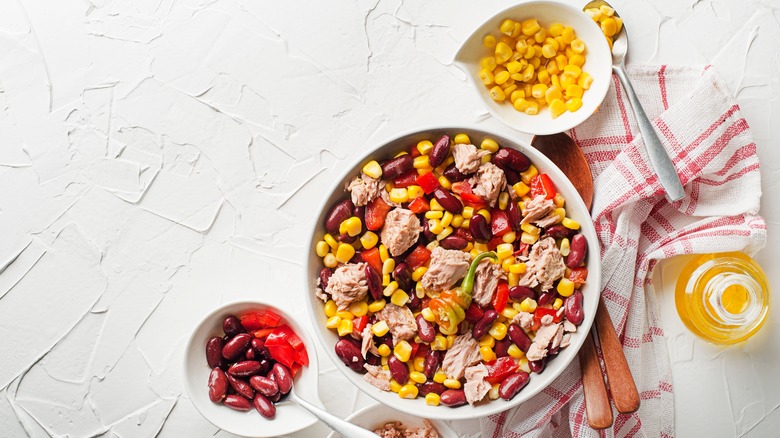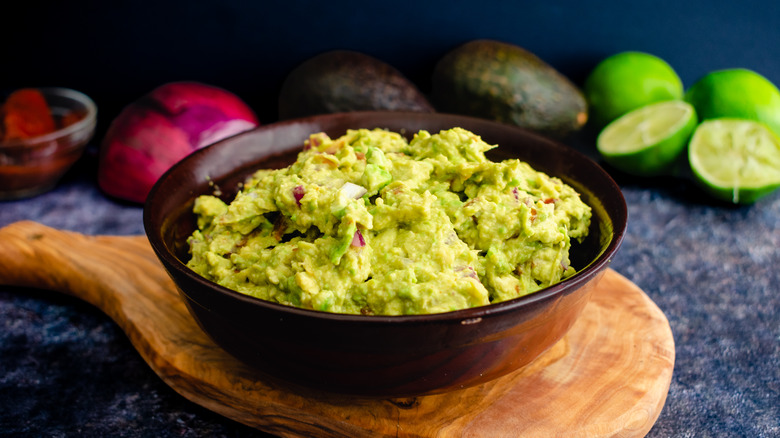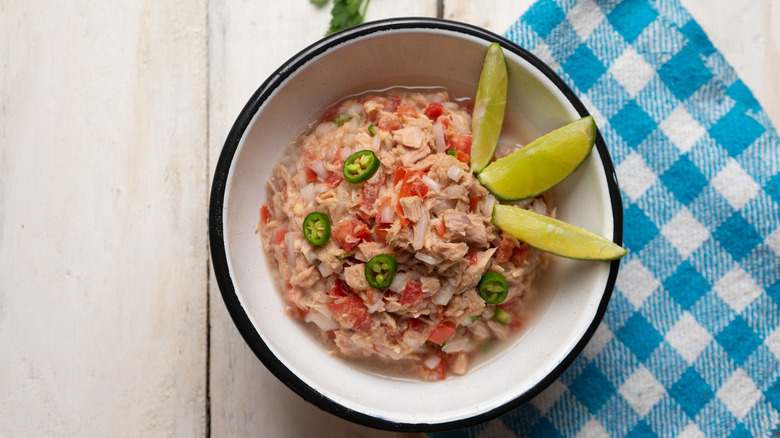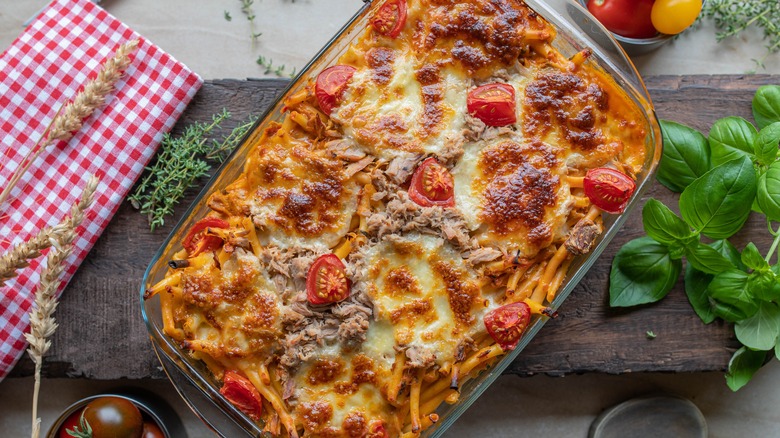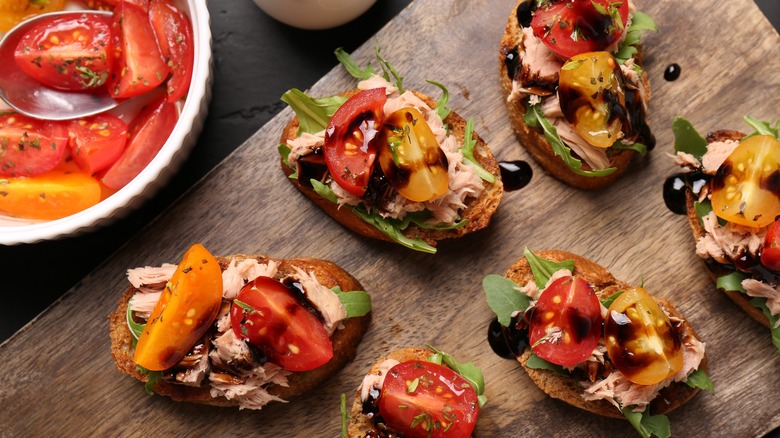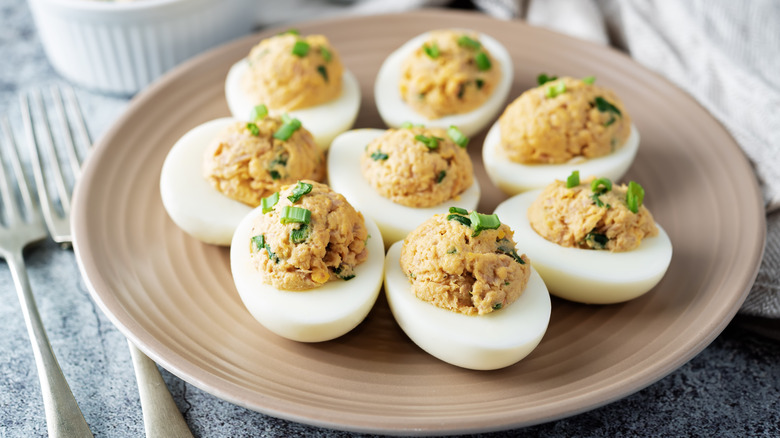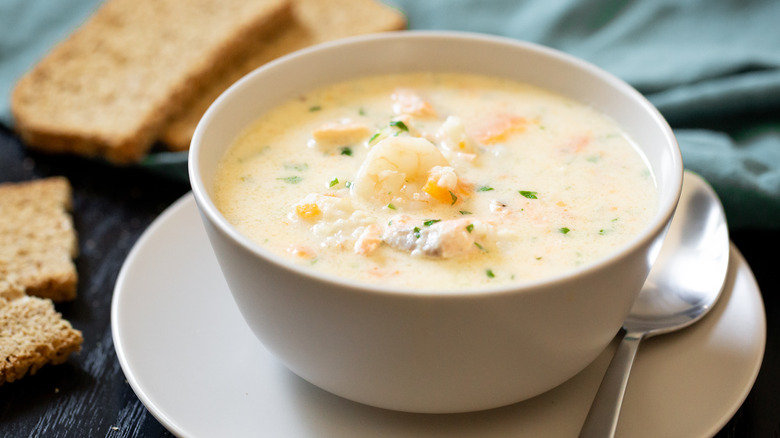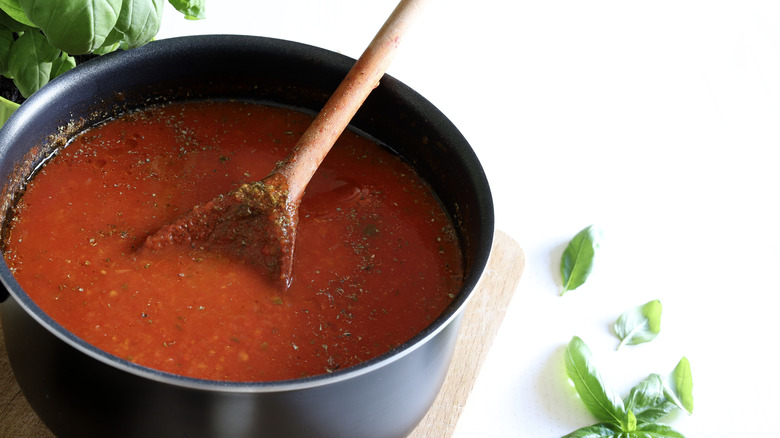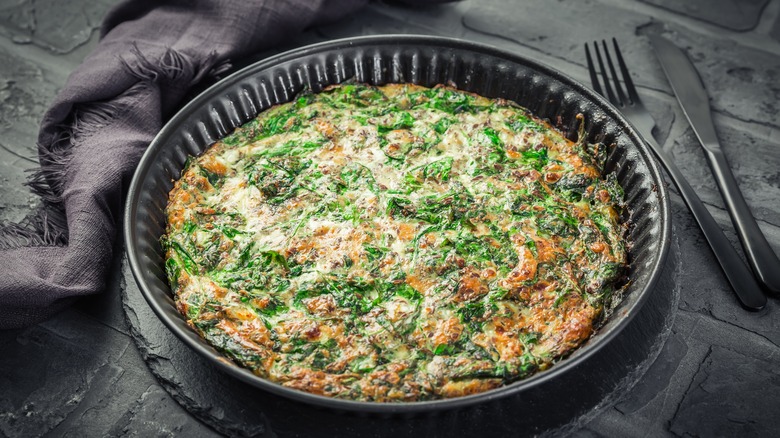13 Ways To Seriously Upgrade Your Canned Tuna
Convenient, affordable, and flavorful, canned tuna is a pantry staple that deserves a regular place in your home and on your menu. Whether you eat it packed in water or oil, there are many potential health benefits of consuming it on a regular basis (though you should perhaps avoid eating tuna daily to minimize the potential side effects of the mercury content in certain varieties). Among the false facts perpetuated about canned tuna is that it's not a sophisticated food to consume and that it cannot taste as good as the fresh iteration of this fish. As a chef with nearly two decades of professional experience, I'm here to tell you this couldn't be farther from the truth.
The possibilities of transforming a can of tuna into a delicacy are contingent on the creativity of the person preparing it; this fish can be highly versatile and even gourmet, depending on the type you purchase and what you pair it with. Whether you're using richly-flavored skipjack, delicate albacore, or splurging on Ventresca, which is sourced from the belly of this fish, the potential for this poisson is practically endless. Canned tuna can be the secret ingredient that totally transforms your culinary game — and I'm here to tell you how to do it.
1. Transform it into croquettes
Perhaps my favorite way to use a can of tuna is to transform it into a luscious croquette. A croquette is just a fancy French word for a cake or patty that is breaded and deep-fried. In this case, the cake is formed from a drained can of tuna packed in water that is seasoned and breaded. While you can deep-fry it, pan-frying, baking, or even air-frying a croquette can yield an equally crispy, golden brown crust with less fat.
When forming croquettes, there are a few things to keep in mind. First, you will need a binder. The most common binders for croquettes are eggs and mayonnaise. These binders hold the flakes of tuna together with any seasonings and aromatics. When incorporating a binder, it's important not to over mix the croquettes, otherwise they'll become dense.
The next thing to consider is the breading. Though panko breadcrumbs are always a good bet because they develop a light, crisp texture when cooked, there are plenty of other options, including corn meal, crushed cornflakes, or pulverized potato chips. The key is to refrigerate the croquettes before you cook them, to ensure they hold together during the cooking process. Once cooked, don't forget to pair the croquettes with a delectable dip or sauce.
2. Brighten it up with pesto
One super easy way to jazz up canned tuna for inclusion in a melt, pasta dish, rice salad, or virtually any other recipe is to combine it with pesto. Anyone who tells you fish and cheese don't mix needs to chill out; in the right combination and context, the two can be a match made in heaven. The saltiness of the parmesan cheese lends umami-rich flavor to drained canned tuna packed in water, helping to elevate it, while the fresh herbs and nuts temper any fishiness.
While you can use store-bought pesto, I advise you to make your own. It's exceptionally easy to put together, and doing so will allow you to change up the precise proportion and types of ingredients used. Among the many types of pesto you can create, some of my personal favorites incorporate sun-dried tomatoes or olives, substitute pistachios or walnuts for pine nuts, and swap garlic scapes or mint for the basil. These permutations allow for greater complexity in flavor and more or less nuttiness, brightness, or savoriness, depending on the specific ingredient swapped.
3. Make it into a dip with hummus
If you're one of the Americans who routinely stocks their refrigerator with a container of pre-made, store-bought hummus, this tuna hack is for you. What's better than plain canned tuna and plain hummus? A dynamite, protein-packed dip that combines these staples. These two powerhouses were made for each other. While it may be tempting to add a dairy product like cream cheese or mayonnaise to your tuna to give it that creamy, dreamy texture, hummus is an infinitely more flavorful option.
As a bonus, there are many different varieties of hummus you can use to jazz up your tuna. Want some heat? Try using a spicy hummus. Want an extra burst of saltiness? Use an olive tapenade hummus. Is garlic your jam? Try a roasted garlic hummus that is sure to keep the vampires away. While you can use any kind of tuna packed in oil or water for this purpose, I recommend the latter, as you won't end up with an excessively fatty mouthfeel. Serve this dynamite dip with crackers, crudités, or any scooping vessel of your choice.
4. Mix it with tapenade and toss it with pasta
Speaking of olives, these salty, umami-rich fruits are dynamite for bringing flavor and texture to many dishes. One of their more exciting iterations is briny tapenade. Tapenade is a Provençale dish that typically combines olives with capers, garlic, and lemon juice. On occasion, anchovies are added for an additional kick of savoriness. In keeping with this tradition, try fusing tapenade with a drained can of tuna packed in oil or water for a dynamite spread that can be used to top bread, crackers, or cucumber slices for a quick appetizer, or tossed with pasta, puttanesca-style, for a quick dinner bursting with flavor.
While you can use any kind of pasta for this purpose, tubular-shaped noodles, like penne, are typically more well-suited to chunky sauces, as they tuck themselves into the pasta's nooks and crannies. To help the pasta grasp the tapenade and tuna mixture, you will want to reserve some of the pasta cooking water. This pasta water is loaded with the starches that have leached out of the noodles as they have cooked to al dente perfection. When added back into the pasta and sauce, these residual starches act like a binder and thickener, helping to adhere the sauce to the noodles.
5. Add it to a classic three bean salad
No doubt canned tuna makes a great addition to salads of all kinds, from pasta and rice to a classic three bean or corn variety. Not only does canned tuna bring a boost of protein to these dishes, it layers them with meaty texture and a punch of savory flavor. The key is using the right kind of tuna.
While some prefer a mild-flavored tuna species, like albacore or tongol, I personally lean toward more robustly-flavored options. For this reason I search for skipjack tuna, which is not only bolder in flavor, it happens to be one of the most popular canned varieties of this fish. It also tends to have lower mercury content, a win for those who may be concerned about this.
In the case of salads, while you may think tuna packed in oil would be a good option since you will likely be adding a vinaigrette of some ilk to the dish, I prefer those packed in water. I find they have a more inherent fishy flavor and will more readily absorb the seasonings and dressing of my choice, rather than tasting like the oil in which they were packaged.
6. Combine it with guacamole for the ultimate sandwich
It's hard to beat the classic tuna sandwich. That said, I get a little bored with just adding mayo and relish to canned tuna for a sandwich. Also, I'm a sucker for anything with an avocado in it. Take a hint from popular avocado toast and combine canned tuna with delectable fresh homemade guacamole for a truly kicked-up tuna sandwich.
Guacamole does a few things for tuna. Obviously, it provides much needed flavor. There's an herbaceous element, thanks to the cilantro, an acidic element, owing to the lime juice, and some mild heat from the jalapeńo. But it also has great textural interest that livens up the flaky tuna, particularly if you add chopped red onion and leave the avocado on the chunky side. When I make guacamole, I often include seasonings to help bolster its flavor. Favorites include cumin and smoked paprika, which confer extra complexity that can really play off the umami elements of the tuna.
7. Turn it into a mock ceviche
Ceviche is a delicacy served across Central and South America in various permutations. The basic recipe combines chunks of raw fish or shellfish with various aromatics, chiles, and seasonings, and cures them in an acid, typically lemon or lime juice. This process effectively cooks the protein by denaturing or breaking it apart, leaving behind flaky, tender, opaque fish that retain vibrant, fresh flavor. The protein simultaneously takes on the tastes of the components of the ceviche while infusing those ingredients with its juices.
While you cannot fully recreate the magic of an authentic ceviche using canned tuna, you can certainly turn it into a mock variation of this dish that is every bit as delicious. Since canned tuna is already cooked, there will be textural differences, and the fish will lack some of the inherent vigor and brightness of flavor of its raw counterpart. That said, if allowed to marinate for at least 30 minutes, the tuna will absorb a lot of the flavors of a classic ceviche, creating an appetizer that can be every bit as impressive.
When using canned tuna for ceviche, do not use one packed in oil, as it will be too greasy and retain too much of the flavor of the fat. I prefer tuna packed in water, and drain it thoroughly using a strainer to ensure no excess salt or water leaches into the mock ceviche.
8. Put it in your favorite macaroni and cheese recipe
It goes without saying that few dishes are as nostalgic as a tuna noodle casserole. This classic has many components that may remind you of a baked macaroni and cheese, namely noodles and a creamy sauce. This similarity is what makes fusing the two, by adding canned tuna, a natural choice. Again, anyone who tells you cheese and fish do not mix is wrong. It's all about context, and this is one instance where it takes two to tango.
When using canned tuna for this dish, the type is less important than how it's packaged. Again, I prefer tuna packed in water to one steeped in oil. Once drained, it can be added directly to the casserole as-is, without any additional preparation. Though I maintain that cheese and tuna can be ideal culinary bedfellows, there is one caveat. You will want to select a melting cheese that is mild in flavor. Though there are many cheeses that have great melting qualities and would be delicious in a plain mac and cheese, some of the stronger-flavored ones, like taleggio or blue cheese, would be a bit too funky and compete with the brininess of the tuna. Stick with basics, like fresh mozzarella, Monterey jack, or a mild cheddar for this purpose.
9. Create a topping for crostini
While we all know canned tuna on bread in the form of a sandwich is delicious, this pantry staple may just be the secret weapon you're looking for to whip up elegant crostini. Similar to bruschetta, crostini are thinly sliced toast points garnished with toppings of various kinds. They are bite-sized finger foods that can easily be passed around and eaten at a cocktail party, without the fuss of using a fork and knife. Though there are no hard and fast rules for what can be used on crostini, my general rule of thumb is that it shouldn't be too heavily loaded with toppings, nor should the resulting treats be so large that you cannot easily pop them in your mouth without making a mess.
When considering what type of canned tuna to use, what you choose should be contingent on how many other ingredients you are adding to the crostini. If you are planning on serving the tuna with a few basic ingredients, go with a bolder-flavored variety, like the rich ventresca. If you want to combine the tuna with a creamy element, like a store-bought onion dip, a milder variety like albacore will be more suitable. The same goes for the choice between tuna packed in oil versus water. Those in oil are far better options where the tuna is the star, while those packed in water are better-suited for combining with other fatty ingredients.
10. Use it in your deviled eggs
Speaking of finger foods served at a party, there is seldom a get-together I attend where deviled eggs don't make an appearance. These ovoid edibles are the perfect pass-around nosh for those who love something slightly creamy and zesty that is easy to pop into your mouth. The only thing that could elevate deviled eggs further is the addition of canned tuna.
The key here is to take advantage of tuna packed in oil. That's right, this is the time for that luscious tuna to shine. Since you are likely adding mayonnaise to the deviled eggs, the oil will not notably alter the flavor of this dish. However, you should still drain the oil and adjust the amount of mayonnaise you use to accommodate any residual fat that may cling to the tuna.
When it comes to the type of tuna you use for this purpose, personal preference comes into play. If you want something with more of an umami-rich, briny bite, opt for a stronger-flavored tuna, like the skipjack variety. For a subtle tuna note, go for a milder albacore. And don't forget to amp up the acidity in these deviled eggs. Such notes will balance out the flavor of the fish.
11. Stir it into a seafood chowder
Few dishes are as comforting as a steaming bowl of seafood chowder. The beauty of a chowder recipe is that you can use any kind of seafood or fish you like in it. If you want to get really bougie, get some fresh shrimp, scallops, clams, and mussels to toss in during the last few minutes of cooking. But if frugality is what you are looking for, canned tuna is a great option for a savory chowder recipe.
In this case, the type of tuna doesn't matter so much as what it's packed in. Tuna packed in water is a better option, so that you don't end up with pools of grease floating around in the finished chowder. You also want to make sure to add the drained, canned tuna toward the end of the cooking process. Canned tuna is already cooked, therefore it just needs to be reheated. And, while some people prefer a super thick chowder, I am not a fan of overly pasty soups. I prefer my chowder scoopable, not thick enough for a spoon to stand up alone in it.
12. Incorporate it into your favorite pasta sauce
Among the many ways you can transform a store-bought pasta sauce is to supplement it with a protein. While ground beef is the most common choice, canned tuna is also a great option. The umami-rich fish tempers the acidity of the tomatoes, adding both texture and a boost of protein. While you can use any sauce you prefer, I tend to be a fan of a bold, spicy arrabbiata, which is generously laden with crushed red peppers. I find the heat of the chili is a delightful accompaniment to the brininess of the fish.
Any type of tuna packed in either water or oil will suffice for this application, but be sure to drain it before adding it to the sauce. You will want to heat the tuna in the sauce before tossing it over your pasta. If you are using a relatively loose pasta sauce that is not overly thick, a long, thin noodle will be just fine for this purpose. Just be sure not to overcook it. A perfectly cooked al dente pasta should have a slight bite to it that allows the noodles to hold up to the sauce without disintegrating under its weight.
13. Whisk it together with eggs for breakfast
One of the most forgiving ways to use up leftover ingredients or languishing pantry items like canned tuna is to hide them in a frittata. Eggs are endlessly versatile and capable of transforming even the most mundane ingredients into something sophisticated and luxurious. The key lies in how you prepare the eggs. While water may make for the fluffiest scrambled eggs, it lacks flavor and complexity. I prefer combining my eggs with some heavy cream or cottage cheese, before seasoning it with kosher salt, pepper, paprika, and dried herbs. For an extra hint of umami flavor that will perfectly complement canned tuna, try adding a dash of Worcestershire sauce to the mix before adding your remaining ingredients.
Any type of canned tuna will work in this instance, though I tend to prefer ones packed in water versus oil. The oil can cause pools of grease to form on top of the frittata, which is not aesthetically pleasing. Before adding the tuna to the eggs, drain the can. Top the whole thing with a mild-flavored melting cheese before baking the frittata in the oven until it's golden brown and puffed up.
